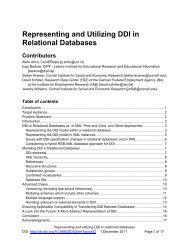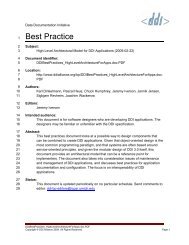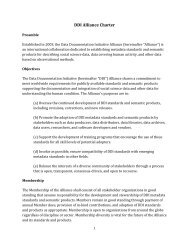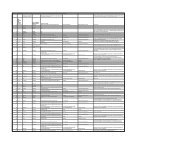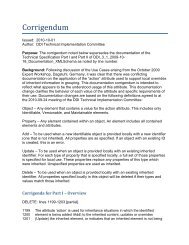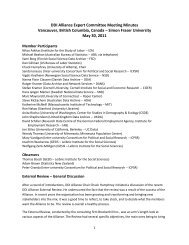DDI Best Practice: Work flows - Data Discovery and Dissemination ...
DDI Best Practice: Work flows - Data Discovery and Dissemination ...
DDI Best Practice: Work flows - Data Discovery and Dissemination ...
You also want an ePaper? Increase the reach of your titles
YUMPU automatically turns print PDFs into web optimized ePapers that Google loves.
<strong>Data</strong> Documentation Initiative8081828384858687888990919293Figure 1: the End User Model] offers a different perspective on it, from the user’s point ofview.Citizenship: Being a contributing member of the full data life cycle <strong>and</strong> realizing that one ispart of a bigger scientific picture.End user: Anyone using any product generated in the data life cycle. Examples includeresearch council/funding bodies, researchers, data producers, archivists, librarians, users,registry managers, research analysts/authors.<strong>Discovery</strong>: Strategies <strong>and</strong> processes used by the end user to locate <strong>and</strong> access products(metadata, data, <strong>and</strong> other related information) of the data life cycle.<strong>Dissemination</strong>: <strong>Data</strong> distribution with the aim of access by the end user to the products(metadata, data, <strong>and</strong> other related information) of the data life cycle.<strong>Data</strong> <strong>and</strong> knowledge repository: Places (may be virtual) where the products (metadata,data, <strong>and</strong> other related information) of the data life cycle are located.Knowledge transfer: The act of sharing the knowledge gained throughout the data life cycle.9495969798991001011021031041051061071081091101111122.2 <strong>Best</strong> <strong>Practice</strong> behaviorAn underlying principle of metadata, data, <strong>and</strong> other information is that it can be shared <strong>and</strong>accessible to a wider user community. The often-disjointed nature of the production ofmetadata throughout the data life cycle can lead to fragmented metadata that canundermine the achievement of this principle. While <strong>DDI</strong> 3.0 was designed to capturemetadata in a dynamic process for the purposes of informing the production process <strong>and</strong>later stages in the model, including data discovery, analysis, <strong>and</strong> re-use, best practice bymetadata producers should ensure consistent <strong>and</strong> exhaustive coverage. Bear in mind thatthese same features in <strong>DDI</strong> 3.0 can increase fragmentation. Metadata producers areresponsible for retaining the metadata integrity throughout the <strong>Data</strong> Life Cycle.From the end user perspective, published metadata should be persistent, versioned, <strong>and</strong>accessible. The quality <strong>and</strong> completeness of the content of the metadata should beevaluated against the best practices of the wider <strong>DDI</strong> community, which should ideally beaddressed through certification.Organizations <strong>and</strong> agencies involved in the production of metadata should seek certificationof their metadata creation processes. Certification should be based on best practices asdefined by the <strong>DDI</strong> community. Institutions with stewardship responsibilities, such as trusteddata <strong>and</strong> knowledge repositories, should establish certification criteria <strong>and</strong> processes.<strong>DDI</strong><strong>Best</strong><strong>Practice</strong>s_<strong>Work</strong><strong>flows</strong>-<strong>Discovery</strong>And<strong>Dissemination</strong>.doc.PDFCopyright © <strong>DDI</strong> Alliance 2009. All Rights Reserved. Page 5




